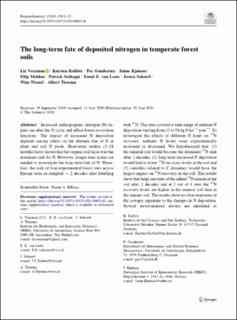| dc.description.abstract | Increased anthropogenic nitrogen (N) inputs can alter the N cycle and affect forest ecosystem functions. The impact of increased N deposition depends among others on the ultimate fate of N in plant and soil N pools. Short-term studies (3-18 months) have shown that the organic soil layer was the dominant sink for N. However, longer time scales are needed to investigate the long-term fate of N. Therefore, the soils of four experimental forest sites across Europe were re-sampled similar to 2 decades after labelling with(15)N. The sites covered a wide range of ambient N deposition varying from 13 to 58 kg N ha(-1)year(-1). To investigate the effects of different N loads on(15)N recovery, ambient N levels were experimentally increased or decreased. We hypothesized that: (1) the mineral soil would become the dominant(15)N sink after 2 decades, (2) long-term increased N deposition would lead to lower(15)N recovery levels in the soil and (3) variables related to C dynamics would have the largest impact on(15)N recovery in the soil. The results show that large amounts of the added(15)N remain in the soil after 2 decades and at 2 out of 4 sites the(15)N recovery levels are higher in the mineral soil than in the organic soil. The results show no clear responses of the isotopic signature to the changes in N deposition. Several environmental drivers are identified as controlling factors for long-term(15)N recovery. Most drivers that significantly contribute to(15)N recovery are strongly related to the soil organic matter (SOM) content. These findings are consistent with the idea that much of the added(15)N is immobilized in the SOM. In the organic soil layer, we identify C stock, thickness of the organic layer, N-status and mean annual temperature of the forest sites as most important controlling factors. In the mineral soil we identify C stock, C content, pH, moisture content, bulk density, temperature, precipitation and forest stand age as most important controlling factors. Overall, our results show that these temperate forests are capable of retaining long-term increased N inputs preferably when SOM availability is high and SOM turnover and N availability are low. | en_US |

